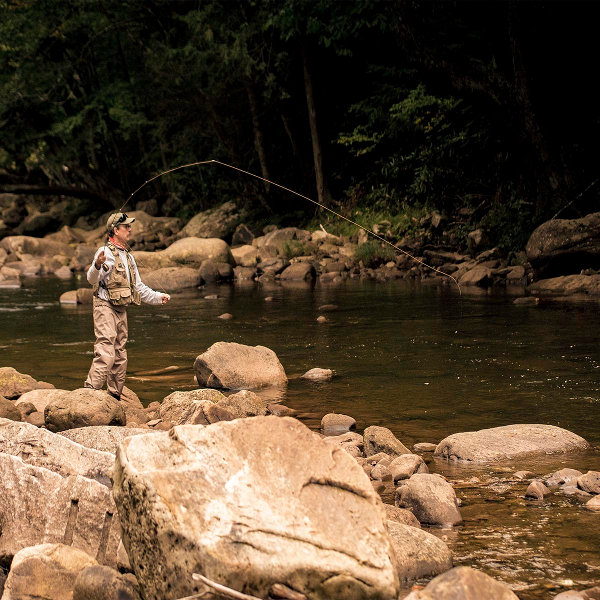
As warm weather returns to West Virginia and the ice prepares to relax its chilly grip on our rivers and streams, anglers are also busy preparing. Rods and reels are checked over, battered line is replaced, and waders are pulled from their dusty lair. Was it the left or right boot you suspected was leaking last year? No matter. Spring is here and the trout are biting! The West Virginia Division of Natural Resources (WVDNR) staff have been hard at work putting together their trout stocking schedule and getting those trout into more than 200 rivers and streams as well as over seventy lakes and ponds throughout the state. And Pocahontas County, with the headwaters of eight rivers, five pristine lakes and countless remote mountain streams, provides some of the best fishing opportunities West Virginia has to offer. So, whether you’re purely a catch and release angler or after fillets for your favorite trout recipes, here’s a brief rundown of just a few of the more popular trout fishing destinations in Pocahontas County.
Cranberry River
Formed by the confluence of its North and South forks, the Cranberry River, it is reported, contains more trout per acre than any waterway in West Virginia. The river is typically viewed in two ways – the backcountry and the lower section. The backcountry portion of the river does not allow for vehicle access. Many anglers, therefore, choose to bicycle in, fish for the day and take advantage of the overnight shelters provided along the sixteen miles of this section of the Cranberry. In contrast to the backcountry, the lower section of the Cranberry is accessible by motor vehicle with roads running near most of the river. Whichever section of the Cranberry you choose, rest assured, browns, brooks and rainbows are waiting.
Williams River
The Williams River originates on Black Mountain, Pocahontas County, and ends at its confluence with the Gauley River. Between those two points flows over thirty miles of rugged, breath-taking wilderness river. The beautiful setting, combined with easy access, has made the Williams a top pick of anglers for years. If you’re looking for a quick one-day outing, the middle portion of the river can be reached from The Highland Scenic Highway. For anglers interested in a longer stay, the Williams River Road (Forest Roads 86 and 216) closely follows portions of the river and offers thirty rustic camp sites, many of which are near the river. Exceptional pools and plenty of instream cover will cause any angler worth his or her salt to say, “Just one more cast.”
Watoga Lake
If your idea of trout fishing is less about being in the water and more about being on the water, Watoga Lake just might be what you’re looking for. Tucked away in the mountains of the southern end of Pocahontas County, Watoga State Park, at 10,100 acres, is the largest state park in West Virginia. And occupying eleven acres of that 10,100 is Watoga Lake. Stocked by the WVDNR, Watoga Lake produces trout well into the Fall and Winter months. Is there a young or new angler in your party? Both bluegill and bass are also stocked – offering a great opportunity for that first-time catch.
Seneca Lake
If a smaller, somewhat secluded body of water is more to your taste, be sure to check out Seneca Lake. This WVDNR stocked three acre lake is a key feature of Seneca State Forest which encompasses nearly 12,000 acres of pristine forest. Due to a good portion of the heavily forested-floor rolling down to meet the water’s edge, this little lake has a “hidden-away” feel. Although no boat launching ramp is available, small boats with electric motors can easily be put in. And as you quietly slip around the lake’s perimeter, who knows, that big trout could be around the very next bend.
Knapp Creek
Knapp Creek, a tributary of the Greenbrier River, has its beginnings on Allegheny Mountain near Frost. The creek makes its way through Minnehaha Springs, Huntersville and joins the Greenbrier River near Marlinton. The WVDNR typically stocks Knapp Creek between Minnehaha Springs and Marlinton once in January, twice in February, weekly March through May and twice in October. This stocked portion of the creek runs parallel to WV Rt. 39 with easy access made by several pull off spots along the road’s shoulder. Long tracts of riffles and still pools provide ample opportunities to tease out a strike from a brook, brown, or rainbow trout.
As you can see, trout stocking in West Virginia is going strong and plays a vital part in giving anglers the perfect trout fishing experience. Why not put Pocahontas County at the heart of that experience? Nature’s Mountain Playground provides the lakes, rivers, streams beautiful scenery and lodging options to make your trout fishing adventure one you’ll never forget – fill out our request information form. With so many options available, the biggest challenge you’ll face this spring may not be which favorite trout fishing lures or trout fishing flies to tie to your line, but where to wet that line. So, whether you’re after brookies, browns, rainbows, or the unique golden trout; whether you prefer fishing rivers, lakes or mountain streams, don’t worry about that leaky wader. Come on in, the water is fine in Pocahontas County.
